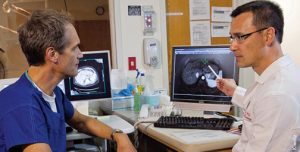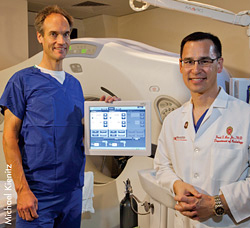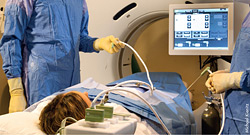
When it comes to launching a successful startup, shared values can help a good idea gain greater momentum. For University of Wisconsin—Madison engineer Dan van der Weide and radiologist Fred T. Lee Jr., those shared values include investing in good people, taking a long-term approach to business and pursuing medical technologies that offer new hope to patients with few other options.
To achieve their goals and remain true to their values, six years ago the two decided to mortgage their homes and put their families’ futures on the line rather than accept funds from outside investors whose goals conflicted with their own. In the years since, they’ve found that while some entrepreneurial challenges require a technical solution, the ability to sit down and work through issues with a common purpose has played an equally important role in their success.
Today, the company they founded, NeuWave Medical, employs 30 people in Madison. The first product, the Certus 140 Ablation System, uses precisely delivered microwave technology to destroy tumors in sensitive tissues including the liver, kidneys and lungs of patients unable to withstand the rigors of surgery. While the Certus device has been on the market for just one year, it already can be found in leading teaching and research hospitals around the nation.
“It wasn’t easy to reach this point, but as a physician, there is no greater feeling than being able to improve a patient’s life with a tool you’ve helped design for that specific purpose,” said Dr. Lee, who is the Robert A. Turrel Professor of Imaging Science and senior vice chair of the Department of Radiology at UW—Madison’s School of Medicine and Public Health. “I mean, what could be better than this?”
With the patented technology now entering the clinical mainstream, the benefits for patients are becoming more evident. For example, use of the minimally invasive ablation technique means a recovery time of just two to three days instead of the usual four to six weeks from major surgery. Instead of a major incision, a needle-like probe is used to destroy the tumor, thus eliminating the need for a lengthy post-operative hospital stay and use of blood transfusions.
The microwave ablation technology also has proven effective as a “bridge” technique to help seriously ill patients on the waiting list for a liver transplant. Patients with advanced liver disease typically have tumors present in their livers, yet current rules to manage the short supply of donor organs set strict criteria regarding the presence of tumors before patients can proceed with a transplant. The Certus system allows for the complete destruction of tumors without the risks or potential delays that accompany surgery and helps patients remain on the active waiting list.
While such benefits are clear now, van der Weide and Lee faced a slew of skeptics as they worked to perfect the product.
“In a way, it was helpful that I was coming from a background outside of medicine, because I didn’t know how many other concepts had failed,” said van der Weide, an electrical and computer engineering professor in UW—Madison’s College of Engineering with several startups to his credit and 17 U.S. patents issued or pending. “But that’s one of the benefits of true collaboration—where you have an intersection of ideas coming from different perspectives.”

After the concept proved successful, the two chose to patent the invention through the Wisconsin Alumni Research Foundation and license the technology for their own startup. Although they were not bound by prior agreements and investigated other options for patenting the device, van der Weide said they opted to work with WARF to better protect against infringement and provide future revenue to the university.
The two also briefly considered the notion of pursuing a relationship with a larger existing company to license and develop the technology. However, the expertise and network of support available through UW—Madison’s College of Engineering and School of Medicine and Public Health convinced them that launching their own company would get the technology into clinical use for the benefit of patients in the most effective way.
The ability to lure experienced executive leadership and find regional suppliers also played a role in their decision to start the young company in Madison.
 “We were able to find exceptional CEO talent with Laura King, who had extensive background leading GE Healthcare’s cardiology and mammography businesses,” van der Weide said. “And thanks to Wisconsin’s strong base of medical device companies and manufacturing operations, we’ve been able to source 80 percent of our components from within the state.”
“We were able to find exceptional CEO talent with Laura King, who had extensive background leading GE Healthcare’s cardiology and mammography businesses,” van der Weide said. “And thanks to Wisconsin’s strong base of medical device companies and manufacturing operations, we’ve been able to source 80 percent of our components from within the state.”
Also key to the company’s founding were [vault vault_id=”107″ profile_link], now an associate professor of radiology in the School of Medicine and Public Health, and [vault vault_id=”108″ profile_link], who earned an MD and PhD through UW—Madison’s medical scientist training program and is now completing his residency at the Stanford School of Medicine.
Lee said NeuWave anticipates hiring additional employees as several new products including a novel surgical cauterizing tool move through the development and approval process. Although van der Weide and Lee are no longer involved in the company’s day-to-day operations, they continue to serve on the board of directors and play a strategic role in the company’s technological progress.
“When we started putting our ideas together, we weren’t sure where it would lead, but our motivation to have better tools to help patients has never wavered,” Lee said. “We hope that by seeing the practical advantages of our collaboration between a doctor and an engineer, others will be inspired to pursue new interdisciplinary projects.”